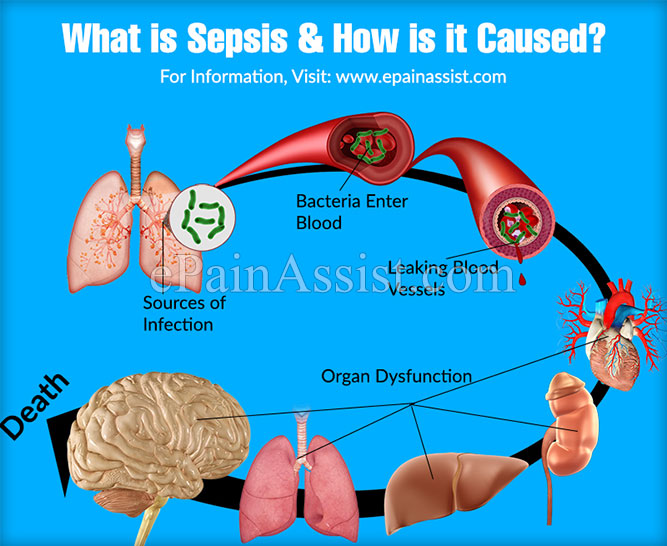Sepsis is a life-threatening complication of infection, which often affects people with weak immune systems. Want to know what sepsis is, what are the long term effects of sepsis and how can it be treated? Read on to know it all.

What is Sepsis & How is it Caused?
Sepsis is a deadly illness triggered by the body’s response to an infection. The immune system is responsible for guarding the body against many infections and diseases. However, at times when responding to an infection, the immune system goes overdrive. Instead of fighting the infection, the chemicals which are released into the bloodstream by the immune system end up causing inflammation throughout the body. This leads to the development of sepsis. Sepsis can be caused by any infection, but the most likely triggers for sepsis are bloodstream infection, pneumonia, kidney infection or abdominal infection. Sepsis itself is not contagious, but the micro organisms which cause the original infection that leads to sepsis can be contagious. Sepsis spreads internally in an individual’s body from its original source to other organs via the bloodstream. Although anyone can get sepsis, newborns, children, seniors, individuals with weak immunity, cancer and HIV patients face a greater risk of contracting this illness. People getting treated in the ICU and ones exposed to invasive devices like breathing tubes and intravenous catheters, etc. are also highly susceptible to sepsis.
What are the Serious and Long Term Effects of Sepsis?
Although sepsis is potentially life-threatening, the illness ranges from mild to severe. The recovery of a person from sepsis depends on the severity of their condition and any pre-existing conditions, which they might be suffering from. While the mortality rate in septic shock is 50%, the recovery rate in mild cases of sepsis is higher. Severe sepsis increases the patient’s risk of a future infection. Severe sepsis and septic shock can also result in complications like formation of small blood clots throughout the body. This can block the normal flow of oxygen and blood to the vital organs leading to heightened risk of tissue death and organ failure.
It can take up to 1.5 years before sepsis survivors begin to feel like their normal self. While people who survive sepsis recover completely, there are others who suffer lasting effects of the illness. According to a research, 50% of sepsis survivors face post-sepsis syndrome (PSS). Certain conditions which result as long-term effects of sepsis are damaged organs, debilitating joints and muscle pains, fatigue, insomnia, poor concentration, nightmares, decreased cognitive functioning and self esteem.
What are the Stages & Symptoms of Sepsis?
There are 3 stages of sepsis namely sepsis, severe sepsis and septic shock. Extreme cases of sepsis can lead to septic shock, which is a medical emergency. Certain symptoms of sepsis are confirmed infection, high breathing rate and heart rate, decrease in normal body temperature and high fever. Having any 2 of these symptoms can indicate potential sepsis. Severe sepsis is indicated by symptoms like breathing problems, unconsciousness, abnormal heart functions, reduced urination, low platelet count, extreme weakness, patches of discoloured skin, changes in mental ability, etc. The symptoms of severe sepsis if accompanied by very low blood pressure indicate septic shock.
How Can Sepsis Be Treated?
Sepsis can progress rapidly to septic shock and can eventually result in the patient’s death if it is left unattended. A number of medications like pain killers, insulin, antibiotics, vasoactive medication, and corticosteroids are available to treat sepsis. Patients with severe sepsis may also need a respirator for breathing and large amounts of IV fluids. Dialysis may also be required if the kidneys are affected. In certain cases, surgery may also be needed to remove the source of infection in sepsis.
How Can Sepsis Be Prevented?
By preventing the spread of infection, one can reduce their risk of developing sepsis. This can be done by taking certain measures like:
- Getting timely vaccinated for pneumonia, influenza and other infections.
- Practicing good hygiene like hand washing, regular bathing and proper wound care.
- Every minute is important when it comes to sepsis treatment. Hence, getting immediate care when signs of infection develop is vital. The sooner the treatment is administered, the better will be the outcome.
Conclusion
It is vital to remember that sepsis is a medical emergency. Since this infection can spread rapidly, each and every minute counts. Sepsis is marked by the appearance of a combination of symptoms. Thus, one should seek immediate medical attention if they experience these symptoms and suspect sepsis, especially if they are already suffering from any known infection. The earlier one gets treated for sepsis, the greater is their chance of survival.
